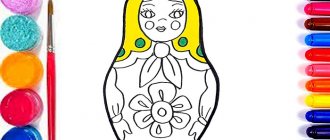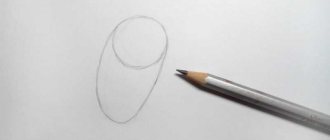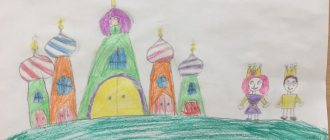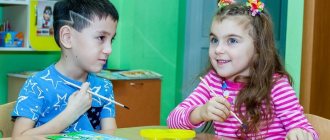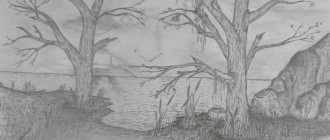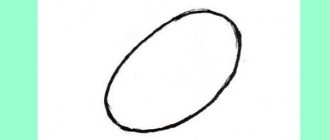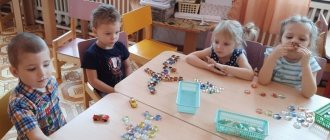SUMMARY OF DRAWING NODES IN THE PREPARATORY GROUP “Draw your favorite toy”
NOTES ON DRAWING IN THE PREPARATORY GROUP
«Draw your favorite toy»
Software tasks:
Educational
: Formation of the ability to draw your favorite toy from memory, clearly conveying the shape of the main parts and characteristic details.
Educational:
Consolidating the ability to draw and paint over a picture, beautifully arranging the image on a sheet of paper. Developing the ability to evaluate your drawing in accordance with the plan. Development of imagination, creativity, talent. Development of fine motor skills of the hands. Promoting the development of descriptive speech (describe the appearance of the toy).
Educational:
Cultivating a caring attitude towards things.
Priority educational area: "
Artistic and aesthetic development
»
Activities:
Communication, play, visual arts, perception of fiction and folklore, motor activity, self-service and basic household work.
Material and equipment:
paper of different formats, colored and simple graphite pencils.
Preliminary work
: Free activities for children in areas of interest. Conversations about favorite toys. Description of an item using a mnemonic table. Invite children to bring their favorite toys from home.
Brief course of OOD:
The teacher reads a poem about toys to the children:
I made a truck for my sister Katyushka. Katyushka raised a cry: “Is this a truck?” Three empty spools. I made her a horse, Let him take it, don’t mind! Katya looks at me, doesn’t want to take the horse: “It’s just a stick!” I folded two flaps. “Oh,” said Katya, “ Oh, what a beauty: a doll in a colorful dress.”
Motivational moment:
Tell me, guys, what is this poem about? That's right, about toys, and also about the ability to fantasize. After all, in order to play with toys, you must be able to imagine, do you agree with me?
Guys, when I was like you, I had one favorite toy, it was a teddy bear. I loved him very much, tried never to part with him. Yesterday I tried to remember what he looked like, but I only remembered that he had black eyes and a red bow on his neck, and what color his fur was... either black or brown... I couldn’t remember. It's such a shame, guys, I grew up and forgot what my favorite toy looked like.
IN.:
I know that you all also have a favorite toy and you will be happy to tell about it.
Some children's stories about the toy.
IN.:
Very cool, I'm so glad that you have favorite toys and you talked so much about them. But as you grow up, the same thing may happen to you as happened to me - you may forget about your favorite toys. What to do? What can you suggest to help us remember them?
Children's answers
: photograph, draw.
Physical education lesson:
Our horse gallops, clop-clop-clop. (they gallop like horses) The clatter of fast feet can be heard. Doll, doll, dance, (squats with a spring) Wave your hand. This is how a top spins - (spinning) It buzzed and lay down on the floor. The plane flies, flies, (arms to the sides) A brave pilot sits in it. And now we are all nesting dolls, (clap our hands) Clap our hands loudly.
Practical part:
IN.:
Guys, let's imagine that we are artists and draw our favorite toys. Children draw their favorite toys from memory or from life, if they brought them. The teacher helps the children with drawings, draws the children’s attention to the features of the toys and their subtleties. Children try to draw the toy as similar to the real thing as possible.
Reflection:
You made very beautiful drawings. Now everyone will describe their favorite toy and tell why they love it. At the end of the lesson, an exhibition is set up for parents, and their workplaces are cleaned.
Summary of a game lesson on drawing in the preparatory group
Drawing lesson in the preparatory group “My favorite toy.”
Goals: to introduce children to toys and their history, to consolidate knowledge about toys. Develop imagination, memory, attention, accuracy. Learn the ability to draw and paint over a picture, and arrange it beautifully on a sheet of paper. Cultivate interest in artistic creativity. Equipment: a simple pencil, colored pencils, an eraser, a landscape sheet. Preliminary work: Reading A. Barto “Toys”. Conversations on the topic. Didactic games: “What has changed?
", "Wonderful bag." Course of the lesson
1. Organizational moment: Watching the cartoon “Living Toy” Educator: Guys, who guessed what we will talk about today? The children answer. Educator. Yes, guys, today we will draw your favorite toy. Guys, let's remember what toys are made of: plastic, fabric, thread, porcelain, clay, rubber, wood Educator: I suggest you guess the riddles: This is a children's playground. The ball is here, the bucket, the shovel. Both boys and girls brought with them... (toys) Look deep into the pipe: like in a fairy tale, the colors formed there into a pattern. A tube is not a microscope. And the colored one... (kaleidoscope) Let's take colored bricks, We'll build any kind of houses, Even a circus for the public. After all, we have... (cubes) I jump on the asphalt, I fly through the yard into the grass. Don’t hide me from your friends, Let’s play with them in... (ball) The girlfriends are different in height, But they look alike, They all sit next to each other, And there’s only one toy. (Matryoshka dolls) What does all this mean? Daughter, but not crying; If you put him to sleep, he will sleep for a day, or two, or even five. (Doll) Educator: Well done, you guessed all the riddles correctly. Why do we need toys at all and where do we get them? Children: Play, buy in the store. Educator: Let's listen to poems about toys. I made a truck for my sister Katyushka. Katyushka raised a cry: “Is this a truck?” Three empty spools. I made her a horse, Let him take it, don’t mind! Katya looks at me, doesn’t want to take the horse: “It’s just a stick!” I folded two flaps. “Oh,” said Katya, “Oh, what a beauty: a doll in a colorful dress.” The days go, go, go, But the toys don't grow. Even the plush watchdog has not grown at all in a year. I took vitamins from Aunt Nina for toys. I gave them chocolate, cake, jam, marshmallows! The elder brother ate everything for them. Well, what about me? I'm standing in the corner! 2. Fizkul Our horse gallops, clop-clop-clop. (they gallop like horses) The clatter of fast feet can be heard. Doll, doll, dance, (squats with a spring) Wave your hand. This is how a top spins - (spinning) It buzzed and lay down on the floor. The plane flies, flies, (arms to the sides) A brave pilot sits in it. And now we are all nesting dolls, (clap our hands) Clap our hands loudly. 3. Educator: Guys, let's imagine that we are artists and we will draw our favorite toys. Children draw their favorite toys 4. Educator: You made very beautiful drawings. Now everyone will describe their favorite toy and tell why they love it. At the end of the lesson, an exhibition is set up for parents.
We recommend watching:
Integrated lesson in the preparatory group “Travelling the Islands” Summary of a lesson on rhythm in the preparatory group Summary of open intellectual and physical education leisure in the preparatory group Classes in the preparatory group on the topic: Labor
Similar articles:
Summary of GCD in the preparatory group on the topic “Creation of the book “We are Olympians!”
Summary of a lesson on designing from waste material in the preparatory group
Summary of GCD in the preparatory group on the topic: “Surprises of Autumn”
Summary of GCD in the preparatory group. In the land of kindness
Summary of GCD in the preparatory group “Journey through the autumn forest”
Abstract of the GCD on decorative drawing in the preparatory group “Painting the Filimonovskaya toy”
Summary of GCD for decorative drawing in the preparatory group.
Theme "Painting of the Filimonov toy"
Goal: Mastering the basics of decorative and applied arts.
Acquaintance with folk craft - Filimonovskaya toy, its characteristic features. Conveying mood in creative work using color, composition, volume, material.
Tasks
Educational:
Expand your understanding of the craft of toy makers.
Learn to paint cut-out paper toy templates with elements of Filimonov painting, and correctly use the basic colors of the craft.
Educational:
Develop children's sense of color and shape.
Develop imagination and creativity.
Educational:
To cultivate interest and love for the beauty of the surrounding world, for folk art, respect for the work of folk craftsmen, pride in one’s homeland.
Give children the opportunity to feel like folk craftsmen.
Materials and equipment:
Toy whistles (hens, cockerels, birds, ladies, soldiers, goats, rams, bears, pigs, etc.); teaching aid (table) with characteristic color combinations and decorative elements; gouache paints, brushes, jars of water.
Preliminary work:
Conversations with children about folk arts and crafts; viewing albums, photographs, drawings, folk crafts, memorizing poems about folk crafts, visual activities on this topic.
GCD move.
Organizing time
The teacher draws the children's attention to the exhibition of Filimonov toys, reads a poem
Educator: There is a village near Tula
The name is Filimonovo . And the craftswomen live there, bringing good things to homes. And the good there is not simple And not gold, silver.
It's called a Filimonovskaya toy.
The necks are strongly stretched out, And the cow, and the giraffe, And the bear, like the Serpent Gorynych Only animals, birds, horses, Young ladies, soldiers. Both cows and bears were liked by the children, so that the heart would be warmed with goodness and beauty, and so that the fairy tale would never leave us.
Children look at the exhibits and share their impressions.
Teacher's story
Throughout Mother Rus' and far beyond its borders, painted whistle toys are known and loved. They got their name from the village of Filimonovo.
It is unknown who made the first toys here and when, we only know that they have been made for a very long time. One of the legends says that the potter Philemon came to these places, discovered deposits of excellent clay and began to sculpt pots and toys from it. The place where he settled was called Filimonovo.
They make toys from clay. It is soft, obedient to the hands and colorful - white, pink, yellow, orange and even black. Filimonovsky craftsmen sculpt from clay - cows, deer, goats with long necks and large horns. They look more like fairy tale animals than real pets.
Filimonovsky toys are elegant, colorful, bright, cheerful, funny.
Educator: Such whistle toys are made by craftswomen with a kind heart and warm, skillful, strong hands. The molded whistle toys are fired in special ovens. Previously, these were earthen ovens that were made in ravines. A brick oven was built there, in which dishes were placed in dense rows, and the voids between the pots were filled with whistles. The roasting was an unusually colorful spectacle. These mighty fires burned until late at night, illuminating the red-hot pots and toys. Toys in the fire first become red-hot and then white-hot. And when the toys cool down, they become white and pink and hard as stone.
Pay attention to the shape of the toys. What is she like? (extended)
It's all about the natural properties of local clay. She is fat and plastic. When drying, the clay quickly becomes covered with cracks; it has to be constantly smoothed with a damp hand, involuntarily narrowing and stretching the body of the figure. This is where refined, elongated, but surprisingly graceful forms appear.
After firing, the toys are painted. Typical colors for this fishery are yellow, red, and green.
The following pattern elements are used for painting: stripes, lines, dots, circles. Lines in various combinations give birth to suns, Christmas trees, rosettes, and geometric patterns. Animals and birds are always painted in a certain order: alternating stripes of different colors run across the body and neck, and only the head and chest are painted in one color, usually yellow. The ladies' jackets and the soldiers' shirts are painted the same color, mostly red. But how much creativity comes from the masters when they draw patterns on the skirts, aprons and pants of their dolls! Only the faces of the toys remain pure white, only the dots are the eyes, the spots are the mouth.
We made toys for the spring holiday, which is called “Whistling”. Spring folk festivals and festivities took place on a large square. On the trays and counters of the crowded spring fair they were selling cheerful goods. Adults and children eagerly took it apart. The whole area was filled with whistling sounds. The people's festivities were noisy, but the loudest sound was the loud whistling. And, of course, they played fun folk games. Let's play the game "Carousel" too.
Physical school
Children stand in a round dance and walk in a circle, reading the poem “Carousel” by V. Berestov.
We are miles away
The carousel won't roll away.
But where can we go without looking back?
Are hares and horses racing?
We're going on a carousel
From fun to fun.
Children begin to read in a quiet voice, walking slowly in a circle. Then they speed up the pace of the poem, and at the same time slowly run after each other.
Educator: Craftsmen can do everything, but you want to show your skills? Become real folk craftsmen and paint Filimonov toys? I invite you to a creative workshop.
Work in a creative workshop
Children choose cut out toy stencils.
The teacher discusses with the children the procedure for completing the work. The child is shown drawing individual elements of Filimonov's painting on a sheet of paper. During the work, the teacher provides children with creative freedom and provides individual assistance.
Analysis of children's works
Educator: Come on, folk craftsmen, show your toys, let's see how beautiful you have turned out. An exhibition of children's works is being organized.
Educator: Well done guys, they did a great job. Showed excellent skills and knowledge. You have turned out to be wonderful masters of the Filimonov toy!
Bottom line.
Educator: Did you like the Filimonov toy? Which one is the most? The Filimonovskaya whistle, which glorified its village in our country and far beyond its borders, must be preserved for the future.
Where did you come to us like this? Everything is simple, no tricky tricks. With a long neck and painted, For children's play and fun. I fell in love with you in early childhood - my grandmother was a craftswoman. You came to me by inheritance From beautiful people from the village. Distances are not scary for you. You are from the ancestors of distant times. These clay sculptures ring the bells of Rus'.
"Draw your favorite toy"
"Draw your favorite toy"
Software tasks:
Educational
: Formation of the ability to draw your favorite toy from memory, clearly conveying the shape of the main parts and characteristic details.
Educational:
Consolidating the ability to draw and paint over a picture, beautifully arranging the image on a sheet of paper. Developing the ability to evaluate your drawing in accordance with the plan. Development of imagination, creativity, talent. Development of fine motor skills of the hands. Promoting the development of descriptive speech (describe the appearance of the toy).
Educational:
Cultivating a caring attitude towards things.
Priority educational area: "
Artistic and aesthetic development
»
Activities:
Communication, play, visual arts, perception of fiction and folklore, motor activity, self-service and basic household work.
Material and equipment:
paper of different formats, colored and simple graphite pencils.
Preliminary work
: Free activities for children in areas of interest. Conversations about favorite toys. Description of an item using a mnemonic table. Invite children to bring their favorite toys from home.
Brief course of OOD:
The teacher reads a poem about toys to the children:
I made a truck for my sister Katyushka. Katyushka raised a cry: “Is this a truck?” Three empty spools. I made her a horse, Let him take it, don’t mind! Katya looks at me, doesn’t want to take the horse: “It’s just a stick!” I folded two flaps. “Oh,” said Katya, “Oh, what a beauty: a doll in a colorful dress.”
Motivational moment:
Tell me, guys, what is this poem about? That's right, about toys, and also about the ability to fantasize. After all, in order to play with toys, you must be able to imagine, do you agree with me?
Guys, when I was like you, I had one favorite toy, it was a teddy bear. I loved him very much, tried never to part with him. Yesterday I tried to remember what he looked like, but I only remembered that he had black eyes and a red bow on his neck, and what color his fur was... either black or brown... I couldn’t remember. It's such a shame, guys, I grew up and forgot what my favorite toy looked like.
IN.:
I know that you all also have a favorite toy and you will be happy to tell about it.
Some children's stories about the toy.
IN.:
Very cool, I'm so glad that you have favorite toys and you talked so much about them. But as you grow up, the same thing may happen to you as happened to me - you may forget about your favorite toys. What to do? What can you suggest to help us remember them?
Children's answers
: photograph, draw.
Physical education lesson:
Our horse gallops, clop-clop-clop. (they gallop like horses) The clatter of fast feet can be heard. Doll, doll, dance, (squats with a spring) Wave your hand. This is how a top spins - (spinning) It buzzed and lay down on the floor. The plane flies, flies, (arms to the sides) A brave pilot sits in it. And now we are all nesting dolls, (clap our hands) Clap our hands loudly.
Practical part:
IN.:
Guys, let's imagine that we are artists and draw our favorite toys. Children draw their favorite toys from memory or from life, if they brought them. The teacher helps the children with drawings, draws the children’s attention to the features of the toys and their subtleties. Children try to draw the toy as similar to the real thing as possible.
Reflection:
You made very beautiful drawings. Now everyone will describe their favorite toy and tell why they love it. At the end of the lesson, an exhibition is set up for parents, and their workplaces are cleaned.
when not to part with him. Yesterday I tried to remember what he looked like, but I only remembered that he had black eyes and a red bow on his neck, and what color his fur was... either black or brown... I couldn’t remember. It's such a shame, guys, I grew up and forgot what my favorite toy looked like.
IN.:
I know that you all also have a favorite toy and you will be happy to tell about it.
Some children's stories about the toy.
IN.:
Very cool, I'm so glad that you have favorite toys and you talked so much about them. But as you grow up, the same thing may happen to you as happened to me - you may forget about your favorite toys. What to do? What can you suggest to help us remember them?
Children's answers
: photograph, draw.
Physical education lesson:
Our horse gallops, clop-clop-clop. (they gallop like horses) The clatter of fast feet can be heard. Doll, doll, dance, (squats with a spring) Wave your hand. This is how a top spins - (spinning) It buzzed and lay down on the floor. The plane flies, flies, (arms to the sides) A brave pilot sits in it. And now we are all nesting dolls, (clap our hands) Clap our hands loudly.
Practical part:
IN.:
Guys, let's imagine that we are artists and draw our favorite toys. Children draw their favorite toys from memory or from life, if they brought them. The teacher helps the children with drawings, draws the children’s attention to the features of the toys and their subtleties. Children try to draw the toy as similar to the real thing as possible.
Reflection:
You made very beautiful drawings. Now everyone will describe their favorite toy and tell why they love it. At the end of the lesson, an exhibition is set up for parents, their workers clean up
Preview:
Drawing lesson in the preparatory group “My favorite toy.”
Goals: to introduce children to toys and their history, to consolidate knowledge about toys. Develop imagination, memory, attention, accuracy. Learn the ability to draw and paint over a picture, and arrange it beautifully on a sheet of paper. Cultivate interest in artistic creativity. Equipment: a simple pencil, colored pencils, an eraser, a landscape sheet. Preliminary work: Reading A. Barto “Toys”. Conversations on the topic. Didactic games: “What has changed? ", "Wonderful bag."
1. Organizational moment: Reading A. Barto “Toys”. Educator: Guys, who guessed what we will talk about today? The children answer. Educator. Yes, guys, today we will draw your favorite toy. Guys, let's remember what toys are made of: plastic, fabric, thread, porcelain, clay, rubber, wood
Educator: I suggest you guess the riddles: This is a children's playground. The ball is here, the bucket, the shovel. Both boys and girls brought it with them. (toys)
Look deep into the pipe: like in a fairy tale, the colors formed into a pattern there. A tube is not a microscope. And colored. (kaleidoscope)
We’ll take colored bricks, we’ll build any kind of houses, even a circus for the public. After all, we have. (cubes)
I'm jumping along the asphalt, flying through the yard into the grass. Don't hide me from your friends, go play with them. (ball)
The girlfriends are different in height, But they look alike, They all sit next to each other, And there is only one toy. (Matryoshka dolls)
What does all of this mean? Daughter, but not crying; If you put him to sleep, he will sleep for a day, or two, or even five. (Doll) Educator: Well done, you guessed all the riddles correctly. Why do we need toys at all and where do we get them? Children: Play, buy in the store. Educator: Let's listen to poems about toys. I made a truck for my sister Katyushka. Katyushka raised a cry: “Is this a truck?” Three empty spools. I made her a horse, Let him take it, don’t mind! Katya looks at me, doesn’t want to take the horse: “It’s just a stick!” I folded two flaps. “Oh,” said Katya, “Oh, what a beauty: a doll in a colorful dress.”
The days go, go, go, But the toys don't grow. Even the plush watchdog has not grown at all in a year. I took vitamins from Aunt Nina for toys. I gave them chocolate, cake, jam, marshmallows! The elder brother ate everything for them. Well, what about me? I'm standing in the corner! 2. Fizkul Our horse gallops, clop-clop-clop. (they gallop like horses) The clatter of fast feet can be heard. Doll, doll, dance, (squats with a spring) Wave your hand. This is how a top spins - (spinning) It buzzed and lay down on the floor. The plane flies, flies, (arms to the sides) A brave pilot sits in it. And now we are all nesting dolls, (clap our hands) Clap our hands loudly.
3. Educator: Guys, let's imagine that we are artists and we will draw our favorite toys. Children draw their favorite toys 4. Educator: You made very beautiful drawings. Now everyone will describe their favorite toy and tell why they love it. At the end of the lesson, an exhibition is set up for parents.
MAGAZINE Preschooler.RF
Objectives: Create conditions for free experimentation with various materials and tools (art and household). Show new ways of obtaining from abstract images (blots), drawings with images of familiar objects, animals, toys. Arouse interest in the objectification and “revival” of unusual forms (blots) using various visual means. Activate the dictionary: blot, reminds, similar. Develop creative imagination and fantasy. Materials: prepared colored sheets of paper, watercolor and gouache paints or gouache, ordinary colored paints or gouache, brushes, water. Methodological support: Teacher: Hello, guys! Today we will draw... (knock on the door). Guys, who is this? Parsley: Hello, guys! I am a cheerful toy and my name is Parsley! (sad) Teacher: Hello, mischievous Parsley! A very bright toy! Are you somehow not mischievous, not cheerful, not funny today?! Still, we are very glad to see you visiting us! Parsley: Where did I end up? What are you doing here? Teacher: This is a fine arts studio. Parsley: What are you doing here? Teacher: Petrushka, the guys from the senior group “...” came to the studio to draw. Parsley: From the older group (surprised)? Are you really that big already? Teacher: Guys, Petrushka doesn’t believe it, let’s show him. (Children show, raise their hands high, stand on their tiptoes.) Parsley: So, you know how to draw? Teacher: Of course, even very good! Parsley: How lucky I was to come to you guys! I really need your help! Teacher: What happened, Petrushka? Parsley: A parcel arrived at our kindergarten, for the youngest children from the “...” group. But while the parcel was coming, the mischievous Morozko blew on it and bewitched it. Now instead of soft, beautiful toys there are nasty, unpleasant blots. The kids will be very upset when they see them. Help, guys, unenchant the toys! Teacher: Of course, Petrushka, the guys and I will help you! But for creative work, the guys need a good mood, and you should smile and cheer us up a little. Parsley: Hands to the heels and ears, On the knees and to the shoulders, To the sides, on the waist, up. And now - cheerful laughter. All the girls are good! Hee hee hee hee hee hee hee! All the boys are good! Ha-ha-ha-ha-ha-ha-ha! Teacher: Well done, Petrushka, you made me laugh! Now you can get to work. Parsley: I would also like to try to disenchant the blot, it’s so interesting! Teacher: Sit down, Petrushka, we are also very interested in what you can do! Practical work for children: The teacher distributes sheets with inkblots. Children choose visual media. Each child chooses a task individually. Parsley and the children talk about the pictures they drew. Teacher: Well done guys, you coped with Parsley’s task! They turned out to be very beautiful toys! I think kids will be happy to receive such bright colorful toys as a gift. Parsley: Bears, dolls, rattles, Stars, balls, crackers, And snowflakes, and parsley, What is all this? Children: Toys! Parsley: Do you take care of toys?Children: Yes!
Parsley: Don’t you let them get bored? Children: No!
Parsley: Well done, I have to go, goodbye kids! (The teacher gives the drawings with a package to Parsley.)
Teacher: Goodbye, Parsley, funny toy!
We ask you to come visit us!
Summarizing. Exhibition of works.
| Next > |
Summary of OD on drawing in the preparatory group “My favorite toy”
Alina Gyatsevichene
Summary of OD on drawing in the preparatory group “My favorite toy”
Abstract of OD on drawing in the preparatory group “My favorite toy ”
.
Objectives: introduce children to toys and their history , consolidate knowledge about toys . Develop imagination, memory, attention, accuracy. Learn the ability to draw and paint over a picture, and arrange it beautifully on a sheet of paper. Cultivate interest in artistic creativity.
Equipment: a simple pencil, colored pencils, an eraser, a landscape sheet.
Reading A. Barto " Toys "
.
Didactic games: “Cut pictures”
,
"Wonderful bag"
.
